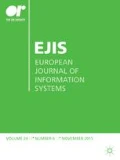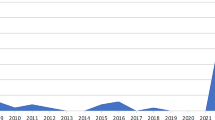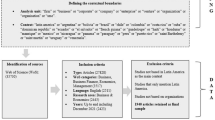Abstract
In information systems (IS) literature, there is ongoing debate as to whether the field has become fragmented and lost its identity in response to the rapid changes of the field. The paper contributes to this discussion by providing quantitative measurement of the fragmentation or cohesiveness level of the field. A co-word analysis approach aiding in visualization of the intellectual map of IS is applied through application of clustering analysis, network maps, strategic diagram techniques, and graph theory for a collection of 47,467 keywords from 9551 articles, published in 10 major IS journals and the proceedings of two leading IS conferences over a span of 20 years, 1993 through 2012. The study identified the popular, core, and bridging topics of IS research for the periods 1993–2002 and 2003–2012. Its results show that research topics and subfields underwent substantial change between those two periods and the field became more concrete and cohesive, increasing in density. Findings from this study suggest that the evolution of the research topics and themes in the IS field should be seen as part of the natural metabolism of the field, rather than a process of fragmentation or disintegration.










Similar content being viewed by others
References
Abbott A (2001) Chaos of Disciplines. University of Chicago Press, Chicago.
Agarwal R and Lucas HL (2005) The information systems identity crisis: focusing on high-visibility and high-impact research. MIS Quarterly 29(3), 381–398.
Akhlaghpour S, Wu J, Lapointe L and Pinsonneault A (2013) The ongoing quest for the IT artifact: looking back, moving forward. Journal of Information Technology 28(2), 150–166.
Albert S and Whetten DA (1985) Organizational identity. Research in Organizational Behavior 7, 263–295.
An XY and Wu QQ (2011) Co-word analysis of the trends in [the] stem cells field based on subject heading weighting. Scientometrics 88(1), 133–144.
Banville C and Landry M (1989) Can the field of MIS be disciplined? Communications of the ACM 32(1), 48–60.
Barabasi AL and Albert R (1999) Emergence of scaling in random networks. Science 286(5439), 509–512.
Bauin S, Michelet B, Schweighoffer MG and Vermeulin P (1991) Using bibliometrics in strategic analysis: ‘understanding chemical reactions’ at the CNRS. Scientometrics 22(1), 113–137.
Bauman Z (1992) Intimations of Postmodernity. Routledge, London.
Benbasat I and Weber R (1996) Research commentary: rethinking ‘diversity’ in information systems research. Information Systems Research 7(4), 389–399.
Benbasat I and Zmud R (2003) The identity crisis within the IS discipline: defining and communicating the discipline’s core properties. MIS Quarterly 27(2), 183–194.
Bernroider EWN, Pilkington A and Córdoba JR (2013) Research in information systems: a study of diversity and inter-disciplinary discourse in the AIS basket journals between 1995 and 2011. Journal of Information Technology 28(1), 74–89.
Björkman I, Fey CF and Park HJ (2007) Institutional theory and MNC subsidiary HRM practices: evidence from a three-country study. Journal of International Business Studies 38(3), 430–446.
Borgatti SP and Everett MG (1999) Models of core/periphery structures. Social Networks 21(4), 375–395.
Bryant A (2008) The future of information systems – thinking informatically. European Journal of Information Systems 17(6), 695–698.
Burt RS (1992) Structural Holes: The Social Structure of Competition. Harvard University Press, Cambridge, UK.
Callon M, Courtial J and Laville F (1991) Co-word analysis as a tool for describing the network of interactions between basic and technological research: the case of polymer Chemistry. Scientometrics 22(1), 155–205.
Callon M, Courtial J, Turner WA and Bauin S (1983) From translations to problematic networks: an introduction to co-word analysis. Social Science Information 22(2), 191–235.
Callon M, Law J and Rip A (1986) Mapping the Dynamics of Science and Technology: Sociology of Science in the Real World. Palgrave Macmillan, Basingstoke, UK.
Cambrosio A, Limoges C, Courtial JP and Laville F (1993) Historical scientometrics? Mapping over 70 years of biological safety research with co-word analysis. Scientometrics 27(2), 119–143.
Carr N (2003) IT doesn’t matter. Harvard Business Review 81(5), 41–49.
Cattani G and Ferriani S (2008) Core/periphery perspective on individual creative performance: social networks and cinematic achievements in the hollywood film industry. Organization Science 19(6), 824–844.
Chang P-L, Wu C-C and Leu H-J (2010) Using patent analyses to monitor the technological trends in an emerging field of technology: a case of carbon nanotube field emission display. Scientometrics 82(1), 5–19.
Chen C, Chen Y, Horowitz M, Hou H, Liu Z and Pelligrino D (2009) Towards an explanatory and computational theory of scientific discovery. Journal of Informetrics 3(3), 191–209.
Clark R (2010) Word-system mobility and economic growth, 1980–2000. Social Forces 88(3), 1123–1151.
Clarke R (2008) An exploratory study of information systems researcher impact. Communication of the Association for Information Systems 22(1), 1–32.
Córdoba JR, Pilkington A and Bernroider EWN (2012) Information systems as a discipline in the making: comparing EJIS and MISQ between 1995 and 2008. European Journal of Information Systems 21(5), 479–495.
Coulter N, Monarch I and Konda S (1998) Software engineering as seen through its research literature: a study in co-word analysis. Journal of the American Society for Information Science 49(13), 1206–1223.
Culnan M (1986) The intellectual development of management information systems, 1972–1982: a co-citation analysis. Management Science 32(2), 156–172.
Culnan M (1987) Mapping the intellectual structure of MIS, 1980–1985: a co-citation analysis. MIS Quarterly 11(3), 341–353.
Dearden J (1972) MIS is a mirage. Harvard Business Review 50(1), 90–99.
Ding Y, Chowdhury GG and Foo S (2001) Bibliometric cartography of information retrieval research by using co-word analysis. Information Processing & Management 37(6), 817–842.
Dwivedi Y and Kuljis J (2008) Profile of IS research published in the European Journal of Information Systems. European Journal of Information Systems 17(6), 678–693.
Dwivedi Y, Williams MD, Lal B and Schwarz A (2008) ‘Profiling adoption, acceptance and diffusion research in the information systems discipline’. In Proceedings of the 16th European Conference on Information Systems, Galway, Ireland, 2008.
Eagle N, Macy M and Claxton R (2010) Network diversity and economic development. Science 328(5981), 1029–1031.
Everett MG and Borgatti SP (1999) The centrality of groups and classes. Journal of Mathematical Sociology 23(3), 181–201.
Foucault M (1972) The Archaeology of Knowledge and the Discourse on Language. Pantheon, New York.
Foucault M (1984) The ethics of the concern for self as a practice of freedom. In Michel Foucault: Ethics: Subjectivity and Truth (Essential Works of Michel Foucault, 1954–1984) (Rabinow P, Ed), pp 281–301, Penguin, London.
Galliers RD (2003) Change as crisis or growth? Toward a trans-disciplinary view of information systems as a field of study. Journal of the Association for Information Systems 4(6), 337–351.
Galliers RD and Whitley EA (2007) Vive les differences? Developing a profile of European information systems research as a basis for international comparisons. European Journal of Information Systems 16(1), 20–35.
Garfield E (1989) Delayed recognition in scientific discovery: citation frequency analysis aids the search for case histories. Current Contents 23(5), 3–9.
Hassan N and Will H (2006) Synthesizing diversity and pluralism in information systems: forging a unique disciplinary subject matter for the information systems field. Communications of the Association for Information Systems 17(7), 152–180.
He Q (1999) Knowledge discovery through co-word analysis. Library Trends 48(1), 133–159.
Hernandez B, Jimenez J and Martín MJ (2009) Adoption vs acceptance of e-commerce: two different decisions. European Journal of Marketing 43(9/10), 1232–1245.
Hirschheim R and Klein H (2006) Crisis in the IS field? A critical reflection on the state of the discipline. Journal of the Association for Information Systems 4(10), 237–293.
Holden RJ and Karsh BT (2010) The technology acceptance model: its past and its future in health care. Journal of Biomedical Informatics 43(1), 159–172.
Hsiao CH and Yang C (2011) The intellectual development of the technology acceptance model: a co-citation analysis. International Journal of Information Management 31(2), 128–136.
Hu C-P, Hu J-M, Deng S-L and Liu Y (2013) A co-word analysis of library and information science in China. Scientometrics 97(2), 369–382.
Keen PGW (1980) ‘MIS research: reference disciplines and a cumulative tradition’. In Proceedings of the First International Conference on Information Systems, paper 9, Philadelphia, USA.
Krebs V and Holley J (2002) ‘Building smart communities through network weaving’. Available from: [WWW document] http://www.orgnet.com/buildingnetworks.pdf (accessed on 20 April 2015).
Larsen T and Levine L (2005) Searching for management information systems: coherence and change in the discipline. Information Systems Journal 15(4), 357–381.
Law J, Bauin S, Courtial J and Whittaker J (1988) Policy and the mapping of scientific change: a co-word analysis of research into environmental acidification. Scientometrics 14(3–4), 251–264.
Law J and Whittaker J (1992) Mapping acidification research: a test of the co-word method. Scientometrics 23(3), 417–461.
Lee MR and Chen TT (2012) Revealing research themes and trends in knowledge management: from 1995 to 2010. Knowledge-based Systems (28), 47–58.
Leydesdorff L (1997) Why words and co-words cannot map the development of the sciences. Journal of the American Society for Information Science 48(5), 418–427.
Leydesdorff L and Hellsten I (2006) Measuring the meaning of words in contexts: an automated analysis of controversies about ‘monarch butterflies,’ ‘frankenfoods,’ and ‘stem cells’. Scientometrics 67(2), 231–258.
Liu G-Y, Hu J-M and Wang H-L (2011) A co-word analysis of digital library field in China. Scientometrics 91(1), 203–217.
Liu Y, Goncalves J, Ferreira D, Xiao B, Hosio S and Kostakos V (2014) ‘CHI 1994–2013: Mapping two decades of intellectual progress through co-word analysis’. In CHI 2014: Proceedings of the SIGCHI Conference on Human Factors in Computing Systems, Toronto, Canada.
Lu K and Wolfram D (2012) Measuring author research relatedness: a comparison of word-based, topic-based, and author cocitation approaches. Journal of the American Society for Information Science and Technology 63(10), 1973–1983.
Marc M, Courtial J, Senkovska E, Petard J and Py Y (1991) The dynamics of research in the psychology of work from 1973 to 1987: from the study of companies to the study of professions. Scientometrics 21(1), 69–86.
Mayer-Schönberger V (2009) Can we reinvent the internet? Science 325(5939), 396–397.
Mingers J (2003) The paucity of multimethod research: a review of the information systems literature. Information Systems Journal 13(3), 233–249.
Monarch I (2000) ‘Information science and information systems: converging or diverging’. In Proceedings of the 28th Annual Conference of the Canadian Association for Information Science, Edmonton, Alberta, Canada.
Muñoz-Leiva F, Viedma-del-Jesús MI, Sánchez-Fernández J and López-Herrera AG (2011) An application of co-word analysis and bibliometric maps for detecting the most highlighting themes in the consumer behaviour research from a longitudinal perspective. Quality & Quantity 46(4), 1077–1095.
Nielsen AE and Thomsen C (2011) Sustainable development: the role of network communication. Corporate Social Responsibility and Environmental Management 18(1), 1–10.
Ocholla DN, Onyancha OB and Britz J (2010) Can information ethics be conceptualized by using the core/periphery model? Journal of Informetrics 4(4), 492–502.
Poell RF, Rocco TS and Roth GL (2015) The Routledge Companion to Human Resource Development. Routledge, Abingdon, UK.
Ritzhaupt A, Stewart M, Smith P and Barron A (2010) An investigation of distance education in North American research literature using co-word analysis. International Review of Research in Open and Distributed Learning 11(1), 37–60.
Rombach MP, Porter M, Fowler J and Mucha P (2014) Core-periphery structure in networks. SIAM Journal of Applied Mathematics 74(1), 167–190.
Rowe F and Truex D (2011) Evaluation and control at the core: how French scholars inform the discourse. In Emerging Themes in Information Systems (Carugati A and Rossignoli C, Eds), pp 45–61, Springer, Heidelberg, Germany.
Shih H-Y (2006) Network characteristics of drive tourism destinations: an application of network analysis in tourism. Tourism Management 27(5), 1029–1039.
Stein M, Galliers RD and Whitley EA (2014) Twenty years of the European information systems academy at ECIS: emergent trends and research topics. European Journal of Information Systems – advance online publication on August 26, 2014 doi:10.1057/ejis.2014.25.
Steyvers M and Tenenbaum JB (2005) The large-scale structure of semantic networks: statistical analyses and a model of semantic growth. Cognitive Science 29(1), 41–78.
Taylor H, Dillon S and van Wingen M (2010) ‘Focus and diversity in information systems research: meeting the dual demands of a healthy applied discipline’. MIS Quarterly 34(4), 647–667.
Valente TW (2012) Network interventions. Science 337(6090), 49–53.
Vaughan L, Yang R and Tang J (2012) ‘Web co-word analysis for business intelligence in the Chinese environment’. ASLIB Proceedings 64(6), 653–667.
Viedma-del-Jesús MI, Perakakis P, Muñoz MÁ, López-Herrera AG and Vila J (2011) Sketching the first 45 years of the journal Psychophysiology (1964–2008): a co-word-based analysis. Psychophysiology 48(8), 1029–1036.
Wang Z-Y, Li G, Li C-Y and Li A (2011) Research on the semantic[s]-based co-word analysis. Scientometrics 90(3), 855–875.
Ward JH (1963) Hierarchical grouping to optimize an objective function. Journal of the American Statistical Association 58(301), 236–244.
Weber R (2003) Editor’s comment: still desperately seeking the IT artifact. MIS Quarterly 27(2), iii–xi.
Williams MD, Dwivedi YK, Lal B and Schwarz A (2009) Contemporary trends and issues in IT adoption and diffusion research. Journal of Information Technology 24(1), 1–10.
Zhao L and Zhang Q (2011) Mapping knowledge domains of Chinese digital library research output, 1994–2010. Scientometrics 89(1), 51–87.
Zong Q-J, Shen H-Z, Yuan Q-J, Hu X-W, Hou Z-P and Deng S-G (2013) Doctoral dissertations of library and information science in China: a co-word analysis. Scientometrics 94(2), 781–799.
Author information
Authors and Affiliations
Additional information
Associate Editors:
Prof. Frantz Rowe and Dr. Raquel Benbunan-Fich
Rights and permissions
About this article
Cite this article
Liu, Y., Li, H., Goncalves, J. et al. Fragmentation or cohesion? Visualizing the process and consequences of information system diversity, 1993–2012. Eur J Inf Syst 25, 509–533 (2016). https://doi.org/10.1057/ejis.2016.5
Published:
Issue Date:
DOI: https://doi.org/10.1057/ejis.2016.5






